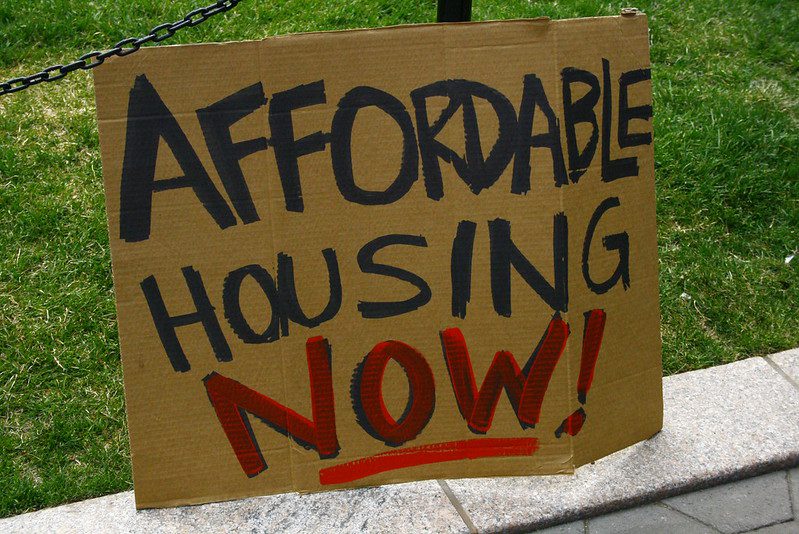Neighborhood leaders know that it is impossible to truly revitalize communities without solving the severe housing abandonment and foreclosure problems plaguing urban areas. It is this premise that led National People’s Action (NPA) to embark on a three year campaign during the Clinton Administration to reform HUD’s Federal Housing Administration’s (FHA) single-family mortgage programs. NPA’s 30-year old coalition of grassroots community organizations fought to bring the former FHA Commissioner Bill Apgar to the neighborhood’s table. Several reforms were won protecting homebuyers. Today, we are working to maintain and strengthen these reforms with the Bush Administration.
By the 1960s, FHA was a predominant source of home finance across America’s suburbs because it provided for a low down payment loan with no risk to lenders. As a result, homebuyers with little cash and less than perfect credit were able to secure an FHA insured mortgage. When FHA homeowners fall behind in their payments and their mortgage goes into foreclosure, HUD reimburses the lender 100 percent of the unpaid loan balance.
Today, the reality for cities where FHA lending is concentrated has turned the American Dream of homeownership into the neighborhood nightmare. Community organizations around the country have witnessed firsthand the devastating effects of abandoned housing and the ensuing crime, drug trafficking, prostitution, child abuse, and disinvestment. In its efforts to track the fraud and abuse in FHA programs, NPA and the National Training and Information Center released a study earlier this year, Families HUD Abandoned, which examined FHA loan default rates in 22 major cities.
The Real Story Behind the Numbers
HUD claims that foreclosures are lower than ever nationally, but this assertion ignores the crisis at the neighborhood level. The national default rate on FHA loans made between 1996 and 2000 is 6.4 percent. However, a closer look reveals the startling reality of families losing their homes and communities plagued with abandoned buildings. This situation is most severe in low-income and minority neighborhoods.
For example, 21 percent of FHA loans made in low-income neighborhoods of Baltimore between 1996 and 2000 defaulted (they were 90 days or more delinquent). Similarly, over 25 percent of FHA loans made by Los Angeles’s third largest FHA lender went into default, and over 20 percent of FHA loans made by Cleveland’s top FHA lender in minority neighborhoods went into default. Equally alarming statistics were found in cities across the country. Despite their incredible default rates, HUD continues to do business with the majority of these lenders. In fact, in FY 2001, HUD paid out over $5.6 billion to lenders in insurance claims on foreclosed properties.
In response to the study, HUD officials claim that foreclosures among FHA loans are down and that they are working hard to keep families in their homes. NPA believes that many foreclosures would be avoided if HUD would exercise its power to make sure unscrupulous lenders, appraisers, and realtors were not setting homebuyers up for failure. In what NPA characterizes as “HUD’s 3-Headed Monster,” HUD-approved lenders, realtors, and appraisers often work together to deceive homebuyers by overvaluing homes, selling shoddy properties to unsuspecting borrowers, or promising repairs or loan deals that never materialize.
Eastside PRIDE in Buffalo has first hand experience with known scams affecting at least 400 FHA homebuyers. Leaders of the grassroots community organization say that HUD’s habit is to point fingers at everyone else but themselves – claiming little fault and no knowledge of the scams being pulled. When asked to help solve the problems and prevent future scams, HUD officials say homebuyer ignorance is to blame, despite proven fraudulent activities.
What HUD Must Do
NPA sat down with Commissioner John Weicher earlier this year to lay out a plan for reforming FHA’s programs. NPA is asking HUD to:
- Enforce its Credit Watch Termination Program by regularly reviewing lender performance and terminating lenders with two times the area’s average default rate,
- Implement Appraiser Watch to terminate appraisers associated with high default rates and unscrupulous practices,
- Prohibit unscrupulous realtors from showing HUD properties,
- Allocate significant funding for the rehab of HUD properties to create new homeownership opportunities and revitalize neighborhoods, and
- Mandate alternatives to foreclosure, penalize lenders who do not work with homebuyers to prevent home loss, and create real foreclosure prevention tools that include financial assistance.
HUD’s response has been lukewarm. Commissioner Weicher and Secretary Mel Martinez are not convinced that the FHA has created a crisis in neighborhoods. Neighborhood leaders suggested that they come out and see the devastation firsthand. To date, our invitation has been declined.
It is within HUD’s authority to squelch these scams and spare neighborhoods further abandonment of HUD properties. NPA calls on the Senate Housing and Banking Committee to hold hearings on what HUD is and isn’t doing to clean up the devastation. Meanwhile, NPA community organizations will continue to keep the pressure on HUD in order to save their neighborhoods.
Inez Killingsworth is co-chair of National People’s Action and president of East Side Organizing Project in Cleveland, OH. Families HUD Abandoned can be downloaded from: www.ntic-us.org. For information about FHA, contact Cathy Klump at the National Training and Information Center, 312-243-3035 or [email protected].
As we go to press, HUD announced that it would launch Appraiser Watch to track default and claim rates on FHA loans where the appraiser reported the value. Public comments can be submitted to HUD through September 23, 2002: Regulations Division, Office of General Counsel, HUD, Room 10276, 471 7th Street SW, Washington, DC, 20410. Refer to Docket No. FR-4744-A-01. back



Comments